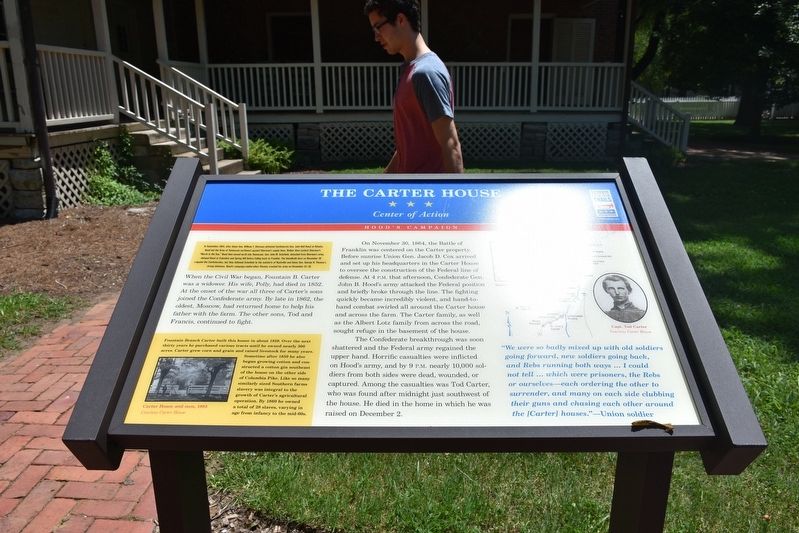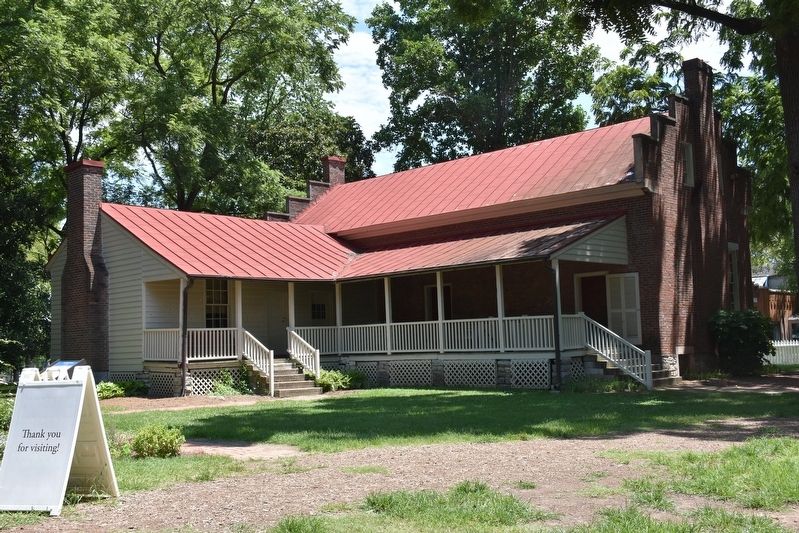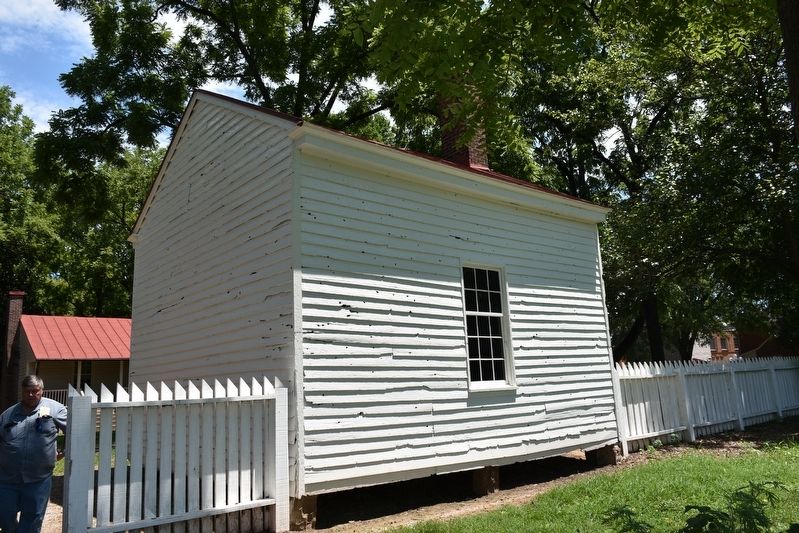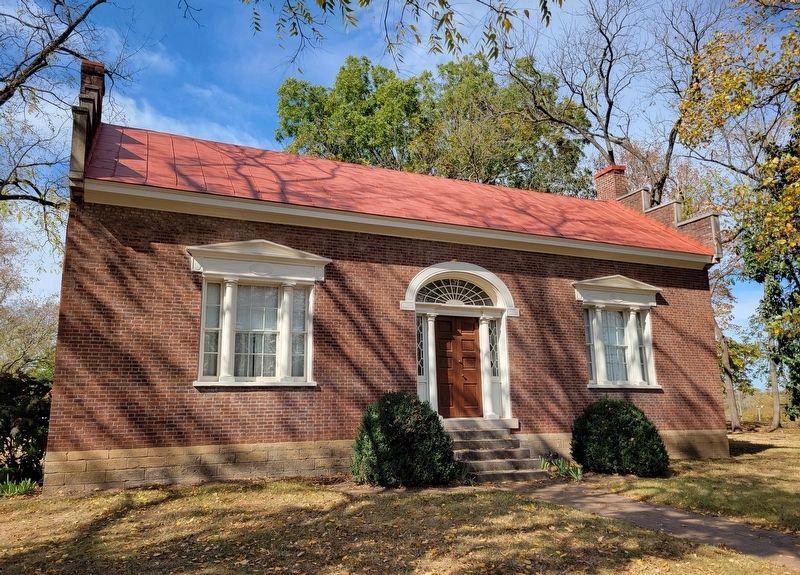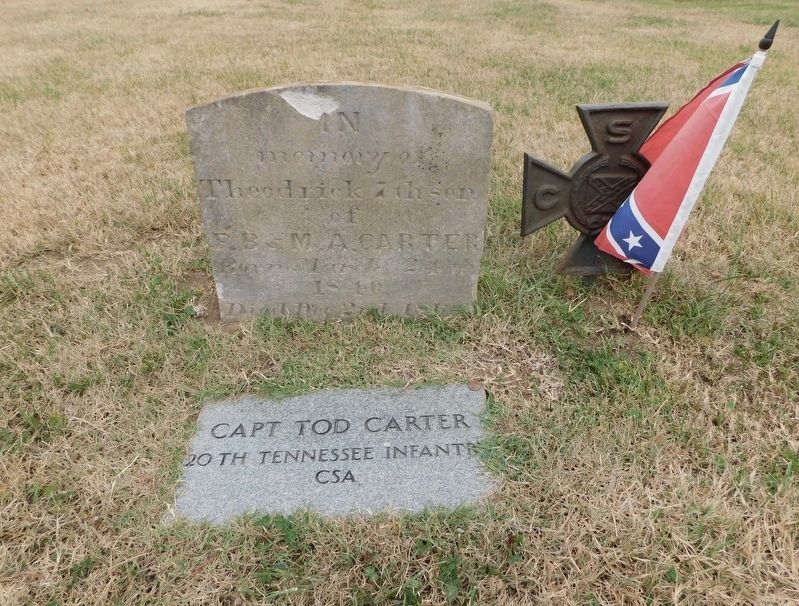Franklin in Williamson County, Tennessee — The American South (East South Central)
The Carter House
Center of Action
— Hood's Campaign —
In September 1864, after Union Gen. William T. Sherman defeated Confederate Gen. John Bell Hood at Atlanta, Hood let the Army of Tennessee northwest against Sherman's supply lines. Rather than contest Sherman's "March to the Sea," Hood then moved north into Tennessee. Gen. John M. Schofield detached from Sherman's army, delayed Hood at Columbia and Spring Hill before falling back to Franklin. The bloodbath here on November 30 crippled the Confederates, but they followed Schofield to the outskirts of Nashville and Union Gen. George H. Thomas's strong defenses. Hood's campaign ended when Thomas crushed his army on December 15-16.
(main text)
When the Civil War began, Fountain B. Carter was a widower. His wife, Polly, had died in 1852. At the onset of the war, all three of Carter's sons joined the Confederate army. By late 1862, the oldest, Moscow, had returned home to help his father with the farm. The other sons, Tod and Francis, continued to fight.
On November 30, 1864, The Battle of Franklin was centered on the Carter property. Before sunrise Union General Jacob D. Cox arrived and set up his headquarters in the Carter House to oversee the construction of the Federal line of defense. At 4 P.M. that afternoon, Confederate Gen. John B. Hood's army attacked the Federal position and briefly broke through the line. The fighting quickly became incredibly violent, and hand-to-hand combat swirled all around the Carter house and across the farm. The Carter family, as well as the Albert Lotz family from across the road, sought refuge in the basement of the house.
The Confederate breakthrough was soon shattered and the Federal army regained the upper hand. Horrific casualties were inflicted on Hood's army and by 9 P.M. nearly 10,000 soldiers from both sides were dead, wounded, or captured. Among the casualties was Tod Carter, who was found after midnight just southwest of the house. He died in the home in which he was raised on December 2.
"We were so badly mixed up with old soldiers going forward, new soldiers going back, and Rebs running both ways...I could not tell...which were prisoners, the Rebs or ourselves—each ordering the other to surrender and many on each clubbing their guns and chasing each other around the {Carter} houses."—Union soldier
(sidebar)
Fountain Branch Carter built this house in about 1829. Over the next thirty years, he purchased various tracts until he owned nearly 300 acres. Carter grew corn and grain and raised livestock for many years. Sometimes after 1850 he also began growing cotton and constructed a cotton gin southeast of the house on the other side of Columbia Pike. Like so many similarly sized Southern farms slavery was integral to the growth of Carter's agricultural operation. By 1860 he owned a total of 28 slaves, varying in age from infancy to the mid-60s.
Erected by Tennessee Civil War Trails.
Topics and series. This historical marker is listed in these topic lists: African Americans • War, US Civil. In addition, it is included in the Tennessee Civil War Trails series list. A significant historical month for this entry is September 1864.
Location. 35° 55.023′ N, 86° 52.407′ W. Marker is in Franklin, Tennessee, in Williamson County. Marker can be reached from Columbia Avenue (Business U.S. 31) north of Strahl Street, on the left when traveling north. Touch for map. Marker is at or near this postal address: 1140 Columbia Ave, Franklin TN 37064, United States of America. Touch for directions.
Other nearby markers. At least 8 other markers are within walking distance of this marker. A different marker also named Carter House (a few steps from this marker); Cleburne’s Division (within shouting distance of this marker); The Carter Farm (within shouting distance of this marker); a different marker also named The Carter Farm (within shouting distance of this marker); Opdycke's Bridgade (within shouting distance of this marker); a different marker also named The Carter Farm (within shouting distance
of this marker); Brown's Division (within shouting distance of this marker); Franklin High School (within shouting distance of this marker). Touch for a list and map of all markers in Franklin.
Also see . . .
1. CPT Theodrick Tod Carter. Civil War Confederate Army Officer. A native of Franklin, Tennessee, He enlisted in the 20th Tennessee (CSA) Infantry, being commissioned as a Captain, and served in that regiment for most of the War, fighting at the Battles of Mill Springs, Shiloh, Perryville, Murfreesboro, Chickamauga, Missionary Ridge, the Atlanta Campaign and ultimately at Franklin. He was captured at Missionary Ridge but escaped and made his way back to the Army, where he was given a position on the staff of General Thomas Benton Smith. At the November 30, 1864 Battle of Franklin, he was mortally wounded a little more than 500 years from his family’s home, the Carter House. Found by family members after the battle, he would die two days later in his home, which is preserved today in Franklin as a Museum. He was also a journalist of sorts, writing reports to several southern newspapers under the name of "Mint Julip". (Submitted on July 19, 2018, by Sandra Hughes Tidwell of Killen, Alabama, USA.)
2. Carter House History. The Carters made their home in this house for 30 years. During that time, E.V. Carter served as a major in the Union Army during the Civil War, returning from the war in 1866 only to die at home, probably from “consumption” contracted during his army service. (Submitted on July 19, 2018, by Sandra Hughes Tidwell of Killen, Alabama, USA.)
Credits. This page was last revised on December 4, 2022. It was originally submitted on July 19, 2018, by Sandra Hughes Tidwell of Killen, Alabama, USA. This page has been viewed 361 times since then and 25 times this year. Last updated on December 16, 2021, by Bradley Owen of Morgantown, West Virginia. Photos: 1, 2, 3. submitted on July 19, 2018, by Sandra Hughes Tidwell of Killen, Alabama, USA. 4. submitted on November 4, 2022, by Bradley Owen of Morgantown, West Virginia. 5. submitted on December 4, 2022, by Bradley Owen of Morgantown, West Virginia. • J. Makali Bruton was the editor who published this page.
